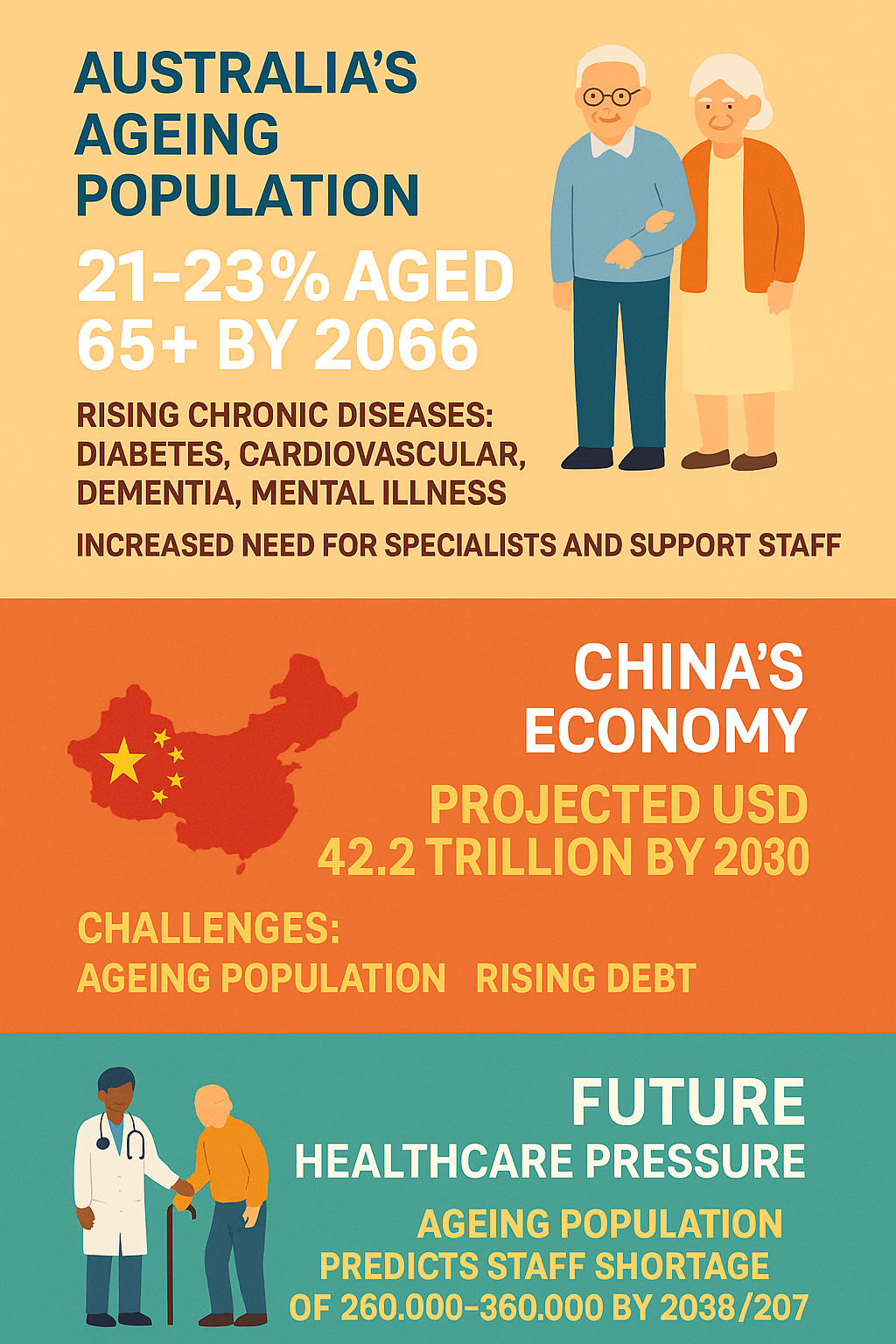Global Scans · Population Ageing & Shrinking Workforces · Signal Scanner
The Emerging Impact of Global Population Ageing on Future Economic and Healthcare Systems
Global population ageing represents a weak but powerful signal that is likely to shape economies, healthcare, and workforce landscapes over the next two decades. While much attention focuses on overall economic growth trajectories, emerging demographic shifts—particularly the rapid increase in elderly populations—pose underappreciated challenges that could disrupt multiple sectors. This article explores the nuances of ageing trends, their complex implications for economic powerhouses, healthcare demand, and workforce shortages, and why these dynamics require broader strategic foresight.
What’s Changing?
The scale and speed of population ageing across the globe are accelerating, particularly in Eastern and Southeastern Asia, regions that are pivotal in the global economy. By 2050, the number of people aged 65 and older in these areas is expected to grow to approximately 1.5 billion (Nature), a demographic shift unprecedented in history.
This widespread ageing coincides with evolving economic power shifts. China, projected to become the largest economy globally at USD 42.2 trillion by 2030, faces constraining factors such as its ageing population and escalating national debt (Economic Times). These demographic pressures could slow China’s long-term growth trajectory and open opportunities for other emerging economies, like India, whose younger demographic profile may enable faster growth and workforce expansion.
Simultaneously, healthcare systems worldwide, particularly in developed regions such as the UK, confront rising strain due to these demographic shifts. The NHS Long Term Plan anticipates a shortage of between 260,000 to 360,000 healthcare staff by 2036/37, mainly driven by the increasing demand for geriatric and chronic disease care (BMJ Open). Such shortages reflect broader trends of health service capacity vulnerability amid workforce ageing, retention challenges, and growing demand.
These connected developments reveal a pattern: ageing populations are not isolated demographic details but catalysts altering economic dynamics, labor markets, public services, and social structures. The pace of ageing, combined with economic and healthcare system responses, can form a significant disruptor across sectors previously considered distinct.
Why Is This Important?
Economic foresight often hinges on GDP forecasts and trend extrapolations; however, demographic transformations can modulate or even override these assumptions. An ageing population could reduce labor force participation rates, suppress productivity growth, and increase dependency ratios, pressuring fiscal budgets through higher pension, social security, and healthcare costs.
For China, an economy aiming to maintain global dominance, population ageing alongside rising debt could stall its rapid expansion and trigger internal policy challenges, potentially recalibrating global economic balances (Economic Times).
Healthcare infrastructure faces compounding pressures as demand increases due to ageing. Staff shortages forecast by the NHS underscore a critical vulnerability in care delivery that could be mirrored worldwide (BMJ Open). This imbalance in demand and supply may accelerate adoption of digital health, AI-assisted diagnostics, and remote care models. However, adaptation timelines and integration effectiveness remain uncertain.
Emerging economies with younger populations, such as India, may reap demographic dividends if they can harness their workforce and avoid premature ageing-related constraints. Conversely, countries failing to prepare adequately confront risks of stagnation, social unrest, and unsustainable public expenditure.
Implications
The ageing demographic trend requires integrated, cross-sector strategic responses rather than isolated adjustments:
- Economic planning: Economies with ageing populations may need to shift toward productivity-enhancing technologies, encourage later retirement, and redesign pension systems to sustain fiscal balance.
- Healthcare innovation: To alleviate staff shortages and growing care complexity, healthcare systems might accelerate telemedicine, AI triage, personalized medicine, and autonomous care technologies, especially for chronic and elderly patient management.
- Workforce development: Skills retraining, migration policies, and incentives for elderly workforce participation could partially offset shrinking labor pools. Intergenerational workforce planning will gain importance.
- Urban and social infrastructure: Planning for age-friendly cities, transportation, housing, and social engagement programs may become critical to maintain quality of life and reduce healthcare burdens.
- Geopolitical-economic shifts: Nations with youthful populations might see accelerated economic growth, while ageing giants could face relative declines, altering global economic and political balances.
Business and government leaders should monitor subtle signals of ageing impact beyond headline statistics. These include changing consumer behavior by older adults, caregiving industry growth, health tech innovation trajectories, and evolving labor market patterns.
Future-forward scenario planning should incorporate variable ageing impact models that address uncertainties around healthcare innovation adoption, migration flows, economic growth elasticity, and policy reactions. Doing so may unearth strategic vulnerabilities and opportunities absent in conventional forecasts.
Questions
- How resilient is the current healthcare workforce to demographic pressures, and what novel models could bridge future service gaps?
- What role might emerging technologies play in extending healthy lifespans and reducing care burdens at scale?
- How will ageing populations influence global economic competition and cooperation over the next 20 years?
- Are current pension and social welfare systems adaptable enough to respond to accelerated ageing without fiscal instability?
- How can organizations redesign their workforce policies to engage older workers and balance generational skills?
- What opportunities arise in service industries targeting ageing populations that remain underexploited?
Keywords
global population ageing; economic growth shifts; healthcare workforce shortage; demographic transition; health technology innovation; pension system reform; intergenerational workforce
Bibliography
- India may emerge as second largest economy by 2038 in PPP terms: EY report. Economic Times. https://economictimes.indiatimes.com/news/economy/india-may-emerge-as-second-largest-economy-by-2038-in-ppp-terms-ey-report/articleshow/123544733.cms?from=mdr
- How will the NHS deliver the workforce needed to meet the Long-Term Plan commitments? BMJ Open. https://bmjopen.bmj.com/content/15/2/e094058
- Population Ageing in Eastern and Southeastern Asia: Forecast to 2050. Nature. https://www.nature.com/articles/s41598-025-94708-5
